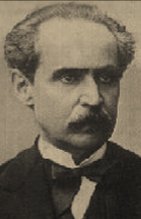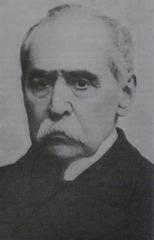
Vicente Fidel López: Visiting Hours, Tickets, and Historical Sites in Buenos Aires
Date: 15/06/2025
Introduction
Nestled in the northern suburbs of Greater Buenos Aires, Vicente Fidel López stands as a vibrant district that beautifully intertwines Argentina’s historical legacy, modern suburban life, and cultural dynamism. Named in honor of Vicente Fidel López, the esteemed historian, writer, and statesman, the partido offers a compelling mix of heritage sites, green spaces, and thriving community life. Whether you are passionate about history, culture, or simply seeking a scenic retreat from the city’s buzz, Vicente López provides a diverse range of attractions and experiences.
For official guidance and further details, visit the Official Buenos Aires Tourism website and explore the biography of Vicente Fidel López.
Contents
- Historical Background and Naming
- Urban Development and Transformation
- Main Landmarks: Visiting Hours and Ticket Information
- Quinta Presidencial de Olivos
- Parroquia Jesús en el Huerto de los Olivos
- Historic Railway Stations
- Paseo de la Costa Waterfront
- Cultural Life and Socioeconomic Significance
- Travel Tips and Accessibility
- Nearby Attractions and Annual Events
- Frequently Asked Questions (FAQ)
- Conclusion
- References
Historical Background and Naming
Vicente López is named after Vicente Fidel López (1815–1903), a prominent Argentine historian, lawyer, and politician. His father, Vicente López y Planes, authored the Argentine National Anthem, cementing the family’s legacy in shaping the nation’s identity (buscabiografias.com). Formally established in 1905, the partido evolved from rural agricultural estates into a suburban enclave, driven by the expansion of the Mitre railway line and the influx of middle- and upper-class residents.
Urban Development and Transformation
The arrival of the Ferrocarril Central Argentino (now the Mitre Line) in the late 19th and early 20th centuries was instrumental in Vicente López’s urbanization. Well-planned neighborhoods such as Olivos, Florida, Munro, and La Lucila blossomed, each offering distinct character and architectural appeal. Today, Vicente López is recognized for its affluent residential zones, green spaces, and a strong sense of community.
Main Landmarks: Visiting Hours and Ticket Information
Quinta Presidencial de Olivos
The Quinta Presidencial de Olivos serves as the official residence of the President of Argentina and remains a central historical symbol. While the estate itself is typically closed to the general public, occasional guided tours and special cultural events are organized. For the latest updates on visiting hours and tickets, consult the Casa Rosada official website or the Vicente López Municipality.
Parroquia Jesús en el Huerto de los Olivos
A striking example of early 20th-century architecture, this parish church is an active center for worship and community gatherings. It is open daily from 9:00 AM to 6:00 PM. Visitors can enter free of charge to admire the interior or attend religious services (es.wikipedia - Vicente López).
Historic Railway Stations
The district’s preserved railway stations, integral to Vicente López’s growth, offer a glimpse into Argentina’s transportation heritage. While most stations are operational, their historic facades can be viewed from public areas and make for interesting stops on walking tours.
Paseo de la Costa Waterfront
The Paseo de la Costa is a scenic promenade along the Río de la Plata, popular for walking, cycling, and outdoor recreation. It features modern art installations, playgrounds, and spectacular sunset views. Open year-round and free to the public, the waterfront is a favorite spot for locals and visitors alike (Wikipedia - Vicente López).
Cultural Life and Socioeconomic Significance
Vicente López boasts a flourishing cultural scene with theaters, art galleries, and community centers. The district was recognized as a UNESCO City of Film in 2023, further enhancing its reputation as a hub for creative industries. Annual events, such as outdoor concerts and art fairs, foster a vibrant community atmosphere. The local economy benefits from a mix of small businesses, educational institutions, and a diverse gastronomic offer blending traditional parrillas with international cuisine (citities.com - Vicente López).
Travel Tips and Accessibility
Getting There
Vicente López is approximately 15 kilometers from downtown Buenos Aires. The Mitre Line train provides frequent service, with stations at Olivos, Florida, and Munro. Numerous bus routes (e.g., 15, 60, 152) and taxis also serve the area. For up-to-date schedules, visit Buenos Aires Public Transport.
Accessibility
Public spaces and most cultural venues are accessible for visitors with mobility needs. The district’s flat terrain, wide sidewalks, and bike lanes support walkability and cycling. However, some older sites may have limited accessibility—check ahead with individual venues if necessary.
Nearby Attractions and Annual Events
Attractions
- Torre Ader: This historic tower offers guided tours on weekends. For schedules and ticket information, refer to the Vicente López Tourism Portal.
- Plaza Vicente López y Planes: A central green space ideal for relaxation and people-watching.
- Museo de Arte Español Enrique Larreta: Located nearby, it showcases Spanish art and culture (Gateway Travel).
Annual Events
- Vicente López Anniversary (January 1st): Marked by concerts, parades, and community celebrations.
- Summer Festivals: Including outdoor movie nights, dance series, and artisanal markets along the waterfront.
Vicente López is also a perfect base to explore neighboring Olivos (with the presidential residence) and San Isidro (noted for its neo-Gothic cathedral and historical quarter).
Frequently Asked Questions (FAQ)
Q: Can I visit the Quinta Presidencial de Olivos?
A: The residence is generally closed to the public but may offer guided tours during special events. Check the Casa Rosada official website for updates.
Q: Are there entrance fees for main attractions?
A: Most outdoor spaces and plazas are free. Theaters and cultural centers may charge event-based tickets. Churches and galleries typically offer free entry, sometimes accepting donations.
Q: How accessible is Vicente López for tourists with mobility challenges?
A: The district is largely accessible, with flat terrain and adapted public spaces. Some older buildings may have limited accessibility features.
Q: What is the best time to visit Vicente López?
A: Spring (September–November) and early autumn (March–May) offer mild, pleasant weather and lively outdoor events.
Q: Is Vicente López safe for tourists?
A: Yes, Vicente López is considered safe. Standard urban precautions apply—avoid displaying valuables and use taxis or rideshares at night (Take A Shans).
Conclusion
Vicente Fidel López is a multifaceted destination that effortlessly combines historical significance, cultural richness, and natural beauty just outside Buenos Aires. From its iconic presidential residence and picturesque waterfront to vibrant cultural events and accessible green spaces, the district delivers an engaging and rewarding Argentine experience. Plan your visit using the information above, and consider downloading the Audiala app for personalized tips, event updates, and guided tours.
References and Official Sources
- Official Buenos Aires Tourism
- Vicente Fidel López Biography
- Vicente López Municipality
- Casa Rosada
- Wikipedia - Vicente López
- Gateway Travel
- Take A Shans
- Citities.com - Vicente López
Images and maps of key landmarks such as Quinta de Olivos, Torre Ader, and the Paseo de la Costa are recommended to enhance your visit and trip planning.






























































































































































